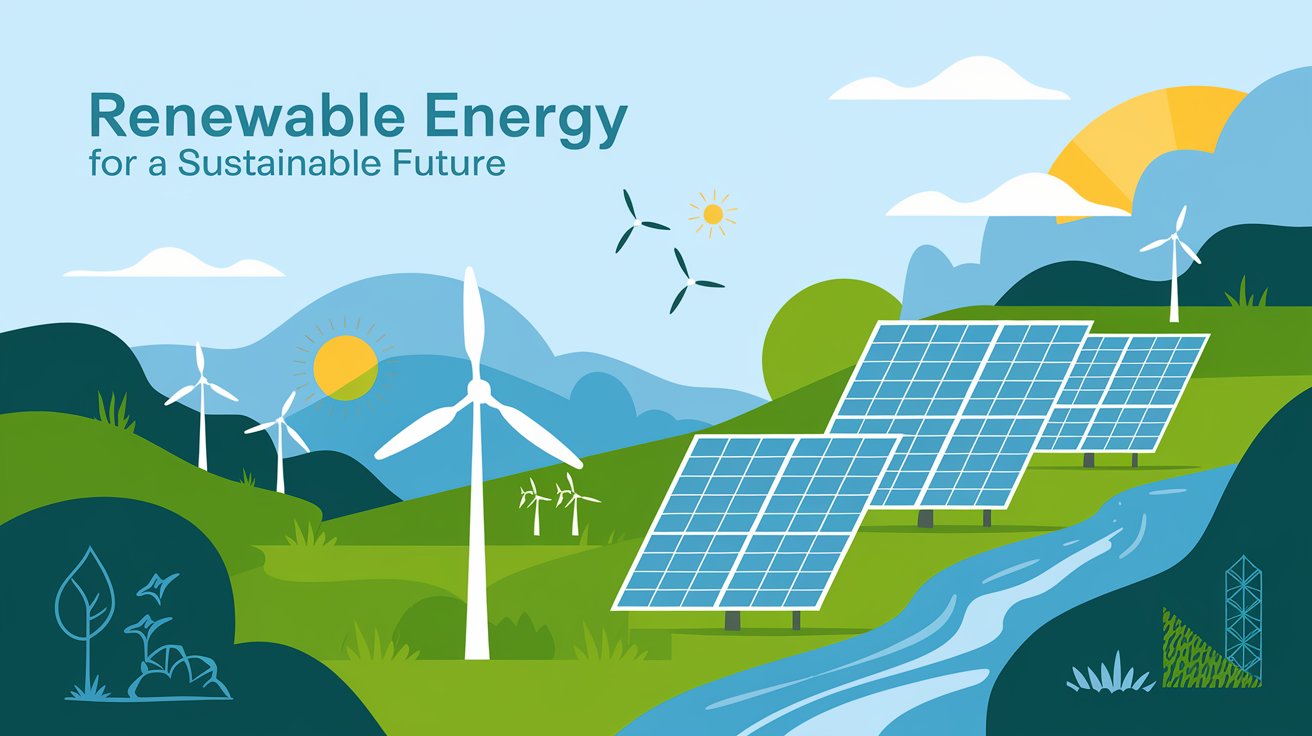Renewable energy refers to energy derived from resources that are naturally replenished on a human timescale. These resources include sunlight, wind, rain, tides, waves, and geothermal heat. Unlike fossil fuels, which are finite and emit harmful greenhouse gases when burned, renewable energy sources are cleaner and sustainable, making them critical in the global effort to combat climate change and reduce our dependence on non-renewable resources such as coal, oil, and natural gas.
As concerns about environmental degradation and climate change have intensified, renewable energy has gained prominence as a potential solution to the world’s energy challenges. While the global energy mix still heavily relies on fossil fuels, renewable energy technologies are advancing rapidly, and their adoption is growing. This blog explores what renewable energy is, its various forms, benefits, challenges, and the role it plays in shaping a sustainable future.
Types of Renewable Energy
There are several types of renewable energy sources, each with unique characteristics and potential for different applications. Some of the most widely used renewable energy sources include:
Solar Energy Solar energy harnesses the power of the sun to generate electricity and heat. The most common method for capturing solar energy is through photovoltaic (PV) cells, which convert sunlight directly into electricity. Solar thermal systems, on the other hand, use the sun’s heat to generate steam, which drives turbines to produce electricity.
Solar energy is an abundant resource. In fact, the Earth receives more energy from the sun in one hour than humanity consumes in an entire year. Solar energy is particularly useful for residential, commercial, and industrial applications. However, its effectiveness depends on geographical location and weather conditions, with solar panels producing the most energy in sunny regions.
Wind Energy Wind energy is generated by converting the kinetic energy of moving air into electricity using wind turbines. Wind farms, which consist of multiple wind turbines, are typically located in areas with strong and consistent winds, such as coastal regions, open plains, or offshore locations.
Wind energy is one of the fastest-growing renewable energy sources due to its high energy yield and low operational costs once the turbines are installed. However, like solar energy, wind energy is intermittent and dependent on weather patterns. Innovations in storage technology are helping to mitigate this issue by storing excess energy produced during high-wind periods for later use.
Hydropower Hydropower, or hydroelectric energy, is generated by harnessing the movement of water, typically from rivers or dams. By allowing water to flow through turbines, mechanical energy is converted into electrical energy. Hydropower is one of the oldest and most reliable forms of renewable energy, supplying a significant portion of the world’s electricity.
There are different types of hydropower systems, including large-scale dams, run-of-the-river systems, and pumped-storage facilities. While hydropower is efficient and cost-effective, its environmental impact can be significant, particularly in terms of ecosystem disruption and habitat loss for aquatic species.
Geothermal Energy Geothermal energy comes from the heat stored beneath the Earth’s surface. This energy can be accessed by drilling wells into geothermal reservoirs and using the heat to generate steam, which drives turbines to produce electricity. Geothermal energy can also be used directly for heating buildings, agriculture, and industrial processes.
Unlike solar or wind energy, geothermal energy is available year-round and is not dependent on weather conditions. However, its use is limited to regions with significant geothermal activity, such as areas near tectonic plate boundaries.
Biomass Energy Biomass energy is produced from organic materials such as plants, agricultural waste, and wood. When these materials are burned or processed, they release stored chemical energy in the form of heat or electricity. Biomass can also be converted into biofuels like ethanol and biodiesel, which can be used in vehicles and industrial applications.
While biomass is considered renewable because it comes from living or recently living organisms, its sustainability depends on responsible sourcing and management. If not properly regulated, biomass production can lead to deforestation, loss of biodiversity, and increased greenhouse gas emissions.
Ocean Energy Ocean energy refers to several types of energy that can be harnessed from the sea. This includes tidal energy, which relies on the gravitational pull of the moon and sun to generate electricity from tidal movements, and wave energy, which captures the kinetic energy of surface waves. Ocean thermal energy conversion (OTEC) is another method that uses the temperature differences between warm surface water and cold deep water to generate electricity.
While ocean energy has significant potential, particularly for coastal regions, the technology is still in its early stages of development. Challenges such as high installation costs, environmental impacts, and the harsh marine environment have slowed its widespread adoption.
The Benefits of Renewable Energy
Renewable energy offers numerous benefits that make it an attractive alternative to fossil fuels. Some of the key advantages include:
Environmental Sustainability Renewable energy sources generate electricity and heat without emitting significant amounts of greenhouse gases or pollutants, making them essential in the fight against climate change. By reducing reliance on fossil fuels, renewable energy helps to lower carbon dioxide (CO2) emissions and mitigate the harmful effects of global warming. Additionally, renewable energy systems typically have a smaller environmental footprint than fossil fuel-based energy production, as they do not require extraction, transportation, or burning of finite resources.
Energy Security As renewable energy sources are locally available, they reduce dependence on foreign oil and gas imports, improving energy security. This is particularly important for countries that rely heavily on imported fossil fuels to meet their energy needs. By investing in domestic renewable energy infrastructure, nations can diversify their energy portfolios and shield themselves from the volatility of global energy markets.
Economic Growth and Job Creation The renewable energy sector is a major driver of economic growth and job creation. The construction, installation, and maintenance of renewable energy infrastructure require skilled labor, which leads to new employment opportunities in industries such as manufacturing, engineering, and construction. Moreover, investment in renewable energy technologies fosters innovation, which can stimulate additional growth in the economy.
Health Benefits Fossil fuel combustion releases harmful pollutants, such as sulfur dioxide (SO2), nitrogen oxides (NOx), and particulate matter, which contribute to air and water pollution and have detrimental effects on human health. By replacing fossil fuels with clean energy sources like wind, solar, and hydropower, renewable energy can significantly reduce air pollution, leading to better public health outcomes, fewer respiratory diseases, and lower healthcare costs.
Infinite Supply One of the most attractive aspects of renewable energy is that it is virtually inexhaustible. Unlike fossil fuels, which are finite and becoming more difficult and expensive to extract, renewable energy sources like sunlight, wind, and water are naturally replenished and abundant. As long as the sun shines, the wind blows, and rivers flow, these energy sources will be available for use.
Challenges of Renewable Energy
Despite its many benefits, renewable energy also faces several challenges that must be addressed to achieve widespread adoption.
Intermittency A major challenge for renewable energy is intermittency, meaning that some sources, such as solar and wind, are not available 24/7. Solar panels, for example, cannot generate electricity at night or during cloudy weather, and wind turbines are only effective when there is sufficient wind. This variability can make it difficult to rely solely on renewable energy for consistent power generation.
Advancements in energy storage technologies, such as batteries, are helping to address this issue by storing excess energy produced during peak generation times for later use. Grid management strategies, including smart grids and demand response systems, are also being developed to integrate renewable energy more effectively into the energy mix.
High Initial Costs The upfront costs of renewable energy infrastructure can be high. Solar panels, wind turbines, and geothermal plants require significant investment in technology, equipment, and installation. However, the operational costs of renewable energy are generally lower than those of fossil fuels, as there are no fuel costs and maintenance expenses are minimal.
Over time, technological improvements and economies of scale have helped to lower the costs of renewable energy, making it more competitive with traditional energy sources. Many governments also provide subsidies, tax incentives, and other financial incentives to promote the development of renewable energy.
Land and Resource Use Some renewable energy projects require large areas of land or access to specific natural resources. For example, solar farms and wind farms often require significant amounts of space, and hydropower projects can disrupt aquatic ecosystems and displace communities. Ensuring that renewable energy development is conducted in a way that minimizes environmental and social impacts is essential for sustainable growth.
The Future of Renewable Energy
Renewable energy is poised to play a central role in the global transition to a more sustainable energy system. Technological advancements in areas like energy storage, grid integration, and renewable energy efficiency are making it easier to harness and distribute clean energy. Furthermore, falling costs and growing political support are accelerating the adoption of renewable energy around the world.
Countries are setting ambitious renewable energy targets, with many aiming to achieve net-zero emissions by mid-century. In addition, international agreements such as the Paris Agreement are driving global cooperation on climate action, pushing governments, businesses, and individuals to embrace renewable energy as part of the solution to climate change.
As renewable energy becomes more integrated into the global energy mix, its potential to transform industries, economies, and communities will only increase. The future of renewable energy is bright, and its continued growth will help ensure a cleaner, healthier, and more sustainable planet for future generations.
Conclusion
Renewable energy offers a powerful solution to many of the world’s most pressing environmental and economic challenges. By harnessing natural resources like the sun, wind, and water, renewable energy provides a cleaner, more sustainable alternative to fossil fuels, while also contributing to energy security, job creation, and public health. While challenges such as intermittency and high upfront costs remain, advances in technology and policy support are helping to overcome these barriers. As the world continues to transition to renewable energy, it will play an increasingly vital role in shaping the future of global energy systems.





